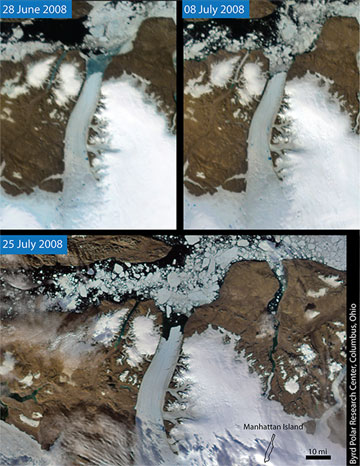NASA images reveal two massive glaciers breaking apart in Greenland
NASA images reveal two massive glaciers breaking apart in Greenland
mongabay.com
August 22, 2008
|
|
Two of Greenland’s largest glaciers are breaking up report researchers monitoring NASA satellite images.
Jason Box, an associate professor of geography at Ohio State, and his colleagues says that an eleven-square-mile (29-square-kilometer) piece of the Petermann Glacier in northern Greenland broke away sometime between July 10th and by July 24th. Petermann glacier has a floating section of ice 10 miles (16 kilometers) wide and 50 miles (80.4 kilometers) long, making it the Northern hemisphere’s longest floating glacier.
Box says that while the break-up is massive, he is especially worried about what appears to be a crack further back from the margin of the glacier.
 A 29 sq. km. (11 sq. mi.) area of the Petermann Glacier in northern Greenland (80?N, 60?W) broke away between July 10th and by July 24th. Petermann has a floating section 16 km (10 mi) wide and 80 km (50 mi) long, that is, 1295 sq. km (500 sq mi); the longest floating glacier in the Northern Hemisphere. Image courtesy of Ohio State University. |
“If the Petermann glacier breaks up back to the upstream rift, the loss would be as much as 60 square miles (160 square kilometers),” Box said.
At the same time that Petermann has splintered, the margin of Jakobshavn glacier has retreated further inland than it has at any time in the past 150 years. Jakobshavn has lost at least three square miles (10 square kilometers) since the end of the last melt season, after losing 36 square miles (94 square kilometers) miles of ice between 2001 and 2005.
Jakobshavn alone is responsible for producing at least ten percent of the icebergs calving off into the sea from the entire island of Greenland, making it the island’s most productive glacier.